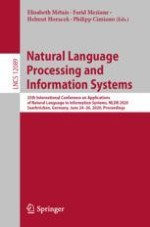2020 | Buch
Natural Language Processing and Information Systems
25th International Conference on Applications of Natural Language to Information Systems, NLDB 2020, Saarbrücken, Germany, June 24–26, 2020, Proceedings
herausgegeben von: Elisabeth Métais, Farid Meziane, Helmut Horacek, Philipp Cimiano
Verlag: Springer International Publishing
Buchreihe : Lecture Notes in Computer Science
